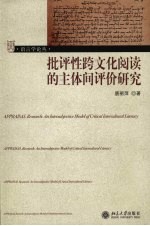
- 作 者:唐丽萍著
- 出 版 社:北京:北京大学出版社
- 出版年份:2006
- ISBN:7301111126
- 标注页数:283 页
- PDF页数:310 页
请阅读订购服务说明与试读!
订购服务说明
1、本站所有的书默认都是PDF格式,该格式图书只能阅读和打印,不能再次编辑。
2、除分上下册或者多册的情况下,一般PDF页数一定要大于标注页数才建议下单购买。【本资源310 ≥283页】
图书下载及付费说明
1、所有的电子图书为PDF格式,支持电脑、手机、平板等各类电子设备阅读;可以任意拷贝文件到不同的阅读设备里进行阅读。
2、电子图书在提交订单后一般半小时内处理完成,最晚48小时内处理完成。(非工作日购买会延迟)
3、所有的电子图书都是原书直接扫描方式制作而成。
Chapter 1 Introduction 1
1.1 Rationales for the present research 1
1.1.1 Educational rationale 1
1.1.2 Linguistic rationale 4
1.2 Aims of the present research 6
1.3 Methodology of the present research 7
1.4 Organization of the book 7
Chapter 2 Literature Review 9
2.1 Introduction 9
2.2 The general historical context of globalization 9
2.3 Philosophical foundations 11
2.3.1 Critical Theory 11
2.3.2 Postmodernism/Poststructuralism 13
2.3.3 Postcolonialism 16
2.3.4 Summary 21
2.4 Pedagogical application 1:Critical Literacy 22
2.4.1 Evolving definitions of literacy 22
2.4.2 Clarification for Critical Thinking and Critical Literacy 23
2.4.3 Two key approaches to Critical Literacy 25
2.4.4 Summary 30
2.5 Pedagogical application 2:Intercultural Communication 31
2.5.1 Evolving definitions of culture 31
2.5.2 Mainstream pedagogy 34
2.5.3 Critical pedagogy 34
2.5.4 Summary 36
2.6 Critical appraisal of implications for Chinese TEFL reform 36
2.6.1 Particular local Chinese context 36
2.6.2 Limited literature of critical approaches to TEFL 39
2.6.3 Implications for Chinese TEFL reform 44
Chapter 3 A Proposed Model for the Present Study 46
3.1 Introduction 46
3.2 Theoretical foundations for the proposed model 46
3.2.1 Critical Discourse Analysis 46
3.2.2 Theories of intersubjectivity 53
3.2.3 Systemic Functional Linguistics and APPRAISAL theory 63
3.2.4 Summary 73
3.3 A proposed model for the present study 73
3.4 Research design 78
3.4.1 Research questions 78
3.4.2 A qualitative approach to discourse analysis 78
3.4.3 Data collection and selection 79
3.5 Summary 82
Chapter 4 Naturalizing Readers 83
4.1 Introduction 83
4.2 Naturalization by ATTITUDE positioning 84
4.2.1 CATEGORY 85
4.2.2 MODE 104
4.2.3 BIAS 111
4.2.4 Summary 120
4.3 Naturalization by ENGAGEMENT positioning 120
4.3.1 MONOGLOSSIA 121
4.3.2 DIALOGIC CONTRACTION 123
4.3.3 DIALOGIC EXPANSION 133
4.3.4 Summary 137
4.4 Sample analysis of two full texts 137
4.4.1 A sample of a comment 138
4.4.2 A sample of a news report 149
4.5 Summary 158
Chapter 5 Actual Readings 160
5.1 Introduction 160
5.2 Introducing a methodological concept—"stimulus" 161
5.3 Letter dialogues to Text 4.4 162
5.3.1 Possible stimuli to be picked up by participants ?A ?E 162
5.3.2 Data:Sample analysis 164
5.3.3 Statistical analysis 179
5.3.4 Discussion 181
5.3.5 Summary 197
5.4 Letter dialogues to Text 4.6 198
5.4.1 Possible stimuli taken up by participants ?F—?J 198
5.4.2 Data:Sample analysis 200
5.4.3 Statistical analysis 214
5.4.4 Discussion 215
5.4.5 Summary 228
5.5 Pedagogical implications 229
5.5.1 Critical intercultural awareness 229
5.5.2 APPRAISAL as critical analytical tools 231
5.5.3 EFL education as empowering practices 234
Chapter 6 Conclusion 237
6.1 Major findings of the present study 237
6.2 Major contributions of the present study 240
6.3 Limitations and further studies 243
Appendices 245
Appendix A:Media texts 245
Appendix B:Letter dialogues to Text 4.4 258
Appendix C:Letter dialogues to Text 4.6 262
Bibliography 266
Figure 3.1:A three-dimensional view of discourse analysis(Fairclough 1992a:10) 48
Figure 3.2:Linguistic strata(Martin 1999:38) 65
Figure 3.3:Genre,register and language(Martin&Rose 2003:254) 65
Figure 3.4:Time frames and semogenesis(Martin&Rose 2003:267) 66
Figure 3.5:Language,register and genre as the projection of their semohistory—across time frames(Martin&Rose 2003:269) 67
Figure 3.6:APPRAISAL system—an overview(summarized from Martin 2000a;White 2003) 70
Figure 3.7:An intersubjective model of CIL 74
Figure 3.8:Elaboration of the intersubjective model of CIL 76
Figure 4.1:Journalistic voices—first cut(White 1998:125) 84
Figure 5.1:Responded frequency of each stimulus picked up by participants ?A—?E 180
Figure 5.2:ATTITUDE repositioning in response to each stimulus by participants ?A—?E 181
Figure 5.3:Responded frequency of each stimulus picked up by participants ?F—?J 214
Figure 5.4:ATTITUDE repositioning in response to each stimulus by participants ?F—?J 215
Table 3.1:Metafunctions(Martin 1991:104) 64
Table 3.2:Metafunctions and Lexicogrammar(Halliday 1978;Matthiessen 1995) 64
Table 4.1:Text-based examples of AFFECT 86
Table 4.2:Summary of AFFECT in Example 4.2 91
Table 4.3:Text-based examples of APPRECIATION 92
Table 4.4:Summary of inscribed APPRECIATIONS in Text 4.1 94
Table 4.5:Text-based examples of JUDGMENT 98
Table 4.6:A comparative picture of the JUDGMENTS targeted on Kerry and Bush in Example 4.6 115
Table 4.7:Summary of APPRECIATIONS targeted on Hollywood in Text 4.4 143
Table 4.8:Summary of the Western representations of the East in Text 4.4 145
Table 5.1:Possible stimuli to be picked up from Text 4.4 163
Table 5.2:Summary of actual readings taken up by?A 167
Table 5.3:Summary of actual readings taken up by?B 169
Table 5.4:Summary of actual readings taken up by?C 171
Table 5.5:Summary of actual readings taken up by?D 174
Table 5.6:Summary of actual readings taken up by?E 178
Table 5.7:Possible stimuli to be picked up from Text 4.6 199
Table 5.8:Summary of actual readings taken up by?F 201
Table 5.9:Summary of actual readings taken up by?G 203
Table 5.10:Summary of actual readings taken up by?H 206
Table 5.11:Summary of actual readings taken up by?I 209
Table 5.12:Summary of actual readings taken up by?J 212
